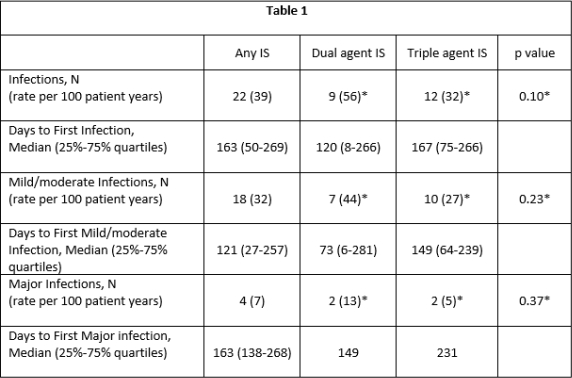How Safe is Immunosuppression Maintenance 1 Year after Renal Allograft Failure?
University of Florida, Gainesville.
Meeting: 2018 American Transplant Congress
Abstract number: D75
Keywords: Infection, Kidney transplantation, Renal failure, Retransplantation
Session Information
Session Name: Poster Session D: Kidney Complications: Late Graft Failure
Session Type: Poster Session
Date: Tuesday, June 5, 2018
Session Time: 6:00pm-7:00pm
 Presentation Time: 6:00pm-7:00pm
Presentation Time: 6:00pm-7:00pm
Location: Hall 4EF
In 2013, our center opened a specialty clinic to maintain immunosuppression (IS) after renal graft failure in an attempt to minimize further sensitization in retransplant candidates. However, concerns over safety–specifically infections–limits widespread acceptance. We present our 1-year post graft failure cohort safety data.
Methods: We retrospectively examined patients at a single center with renal graft failure between 7/2011-10/2016 who were referred to our specialty clinic for maintenance IS. Outcomes analyzed included 1-year infections, cancers, IS, and mortality. A major infection was defined as either requiring hospitalization >1 week or necessitating IS withdrawal.
Results: Our cohort consisted of 56 retransplant candidates. At graft failure, 66% patients were on triple agent IS (usually low dose CNI, mycophenolate, and prednisone), 29% on dual IS and 5% on single IS. 18 patients saw 22 infections for a rate of 39 infections per 100 patient years. Median days to first infection 163 days [25%-75% quartiles 50-269] (Table 1). 4 major infections (7%) required IS withdrawal while the remaining 18 mild/moderate infections were treated while maintaining IS. A third of infections were related to dialysis catheters. No statistical difference in infection rates were seen between dual and triple agent IS (Table 1). 11 patients had IS withdrawn (median 165 days, IQR 118-211) most commonly due to infection (4) followed by malignancy workup (2) which eventually turned out benign. Other complications included 3 nonmelanoma skin cancers, 3 nonfatal cardiac events, 2 leukopenia, and 2 diarrhea. Only 1 death occurred due to voluntary dialysis withdrawal. 71% of retransplant candidates were relisted at 1 year.
Conclusion: Despite the many concerns about maintaining IS after graft failure, 80% of our retransplant candidates still tolerated at least 1 year of IS post graft failure. A third of patients developed an infection. Special attention should be given to minimizing dialysis catheter infections. No worrisome safety signals were seen with malignancy or death.
CITATION INFORMATION: Mena-Gutierrez A., Alquadan K., Santos A., Womer K., Casey M. How Safe is Immunosuppression Maintenance 1 Year after Renal Allograft Failure? Am J Transplant. 2017;17 (suppl 3).
To cite this abstract in AMA style:
Mena-Gutierrez A, Alquadan K, Santos A, Womer K, Casey M. How Safe is Immunosuppression Maintenance 1 Year after Renal Allograft Failure? [abstract]. https://atcmeetingabstracts.com/abstract/how-safe-is-immunosuppression-maintenance-1-year-after-renal-allograft-failure/. Accessed December 12, 2025.« Back to 2018 American Transplant Congress

